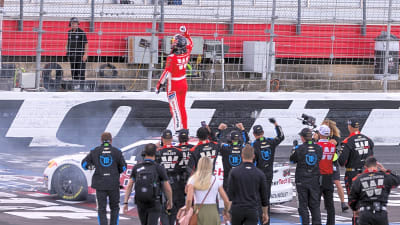Powder aims to feature only the best products and services. If you buy something via one of our links, we may earn a commission.
Blackcrows’ Corvus was their Day 1 ski. These were the sticks that helped put the iconic French brand on the map back in 2007. It’s had many incarnations since then, but has largely stuck to the tune of being a heavy-metal freeride charger that’s topped FWT podiums, starred in movie segments, and been on the feet of aggressive skiers charging big lines all over the world. It’s been the type of tool for those of us who want to go as fast as possible on open faces, big bowls, and anywhere the ski has some room to maneuver.
Last year, Blackcrows decided to change things up a bit with a totally new shape, and the addition of a touch of camber underfoot. For 2026, the ski remains unchanged, save for a topsheet update. The new shape looks unlike anything I’ve seen from the brand, with an entirely re-designed tail. The skis’ side profile now looks more like an Atomic Bent 110 or Salomon QST X with a dramatic tip and tail rocker, but the tail’s shape is almost what I’d categorize as a pin tail, akin to what you’d find on a 4FRNT Hoji or Raven. Inside, there’s a traditional poplar/beech core and single sheet of titanal. Tip and tail widths remain in the same ballpark as before, but underfoot, the waist width has bumped back up to 110mm, substantially increasing the sidecut radius to 25 meters. Some older versions of the ski had similar numbers, but all with a flat tail. Luckily, it’s still pink.
Blackcrows Corvus Specs
- Size skied: 186cm
- Lengths available: 169cm, 176cm, 181cm, 186cm, 191cm
- Sidecut: 137mm - 110mm - 120mm
- Radius: 25m (186.2cm)
- Profile: Freeride rocker
- Weight: 2075g (186cm)
Shape, Flex and Construction:
Modern problems require modern solutions, they say. At first sight, the new Corvus is doens't look particularly different, but dig into the details and you'll quickly see that it's perhaps one of the most unique ski shapes of the year. The front half of the ski looks similar to before, but the rear end features loads of rocker, a pintail, and even a mini-swallowtail cutout. There's also that extremely long 25-meter turn radius.
Somewhat surprisingly, the ski is quite soft, especially in the tip. Underfoot, the flex ramps up significantly. Inside, a poplar and beech core keep things lively without sacrificing edge grip and stability.
I skied the new Corvus in the 186.2cm length, and found it great for my size. The newly-added tail rocker helps the ski feel a bit shorter than its size implies and consequently, the mount point has come forward a good amount. Somehow, the skis feel both short and long at the same time, depending on how fast you're moving. At slower speeds, it’s easy to pivot and smear the ski, but at high speeds, the 25-meter turn radius really helps to add stability and keep the ski tracking straight.
The recommended mount point is now fairly centered at -6cm from the true center, but I messed around with going slightly more forward and found I preferred a -5cm mount the best (+1 from the line). Subtle, but it was noticeable. I felt the right amount of centered and it gave the ski a bit of a looser feel at slow speeds without compromising high-speed stability.
On-Snow Performance
While maneuverable and easy to pivot in tight spaces, I wouldn’t really call this a “playful” ski. Instead, the Corvus shines when it has room to breathe. It wants to go fast–like really fast–and make quick work of wide open runs. That 25-meter turn radius is enormous, especially noticeable when you put it on edge, where not much happens until you push hard and make it happen.
The tails release easily if you shift your weight slightly forward and toss them sideways, but want to hook up and return to straight the second you let go. That gives the ski a very unique character, especially in deep snow, where I felt incredibly comfortable going really really fast knowing that I could shut it down by tossing them sideways at will.
When I first hopped aboard them, I wanted to call the Blackcrows Corvus an “Atomic Bent 110 with a longer turn radius,” but that wouldn’t really do it justice. While the twin-tip rocker profile might give it surface-level vibes of wanting to be a freestyle-friendly ski, it’s not. It’s super stiff and doesn’t have much energy and pop in it the way a softer, bouncier ski like the Bent does. Consequently, it’s not nearly as fun on soft inbounds days or on piste, but is much more solid and reliable when things get tracked up, cruddy, or even slushy and you still want to ski fast - you’ll just need strong legs. I tested these both in deep powder and on firm snow, and found that they don’t really prefer one over the other. The long turn radius and camber underfoot equates to a very solid edge hold on hard snow, but the rocker profile and stiffness allows them to plane and stay on top of the deep stuff.
The really stiff back half of the ski (I say “back half” because the rearmost 10cm or so are quite soft) gives a solid platform when leaning back through chopped up outruns and when landing airs. Despite the twin-rocker profile, it doesn’t want to wheelie out the way softer skis would.
The type of terrain where I think the Corvus works best is sidecountry-access freeride skiing. At 2075g, they’re on the heavy end for me to dedicate for touring bindings, so I’d keep these for backcountry riding with a little help from a machine. For me in the Tetons, that’s the kind of skiing found on Cody Peak, in Granite Canyon, or the backside of Targhee, where there’s plenty of room to open up the throttle in the steeps, lots of big airs to hit, and the snow is variable from deep powder to windbuff. I could see this ski being a hoot in places with similar terrain like Alyeska, Palisades, Silverton, or much of the Alps. Chamonix, anyone?
I think the biggest drawback to a ski that wants to go fast and can handle it is a lack of playfulness and fun at slower speeds. Sure, you can smear around and ski sideways all day long, but it’s hard to put the Corvus on edge and get a response out of it unless you’re charging. In other words, despite the relatively soft tips and tails, it’s not a very forgiving ski and doesn’t really tolerate lazy skiing.
Secondly, the Corvus is one of the least poppy skis I think I’ve ever been on. It prefers to flatten everything in its path, so don’t expect to be loading the tails and boinging off cat tracks to impress your friends with your unbridled steeze. Instead, show them how fast you can straightline that couloir and rip turns down the apron like Nikolai Schirmer.
What type of skier is the Blackcrows Corvus best for?
This is the ski for freeriders looking for a one-ski quiver. Your perfect day might look like this: The mid-season hero day. It's a stable bluebird morning and you catch the first Tram at JHMR, hiking Cody Peak and ripping a line of your choice at full throttle in fresh snow. Follow that by chasing your friends around inbounds for the afternoon dropping cliffs and skiing as fast as possible. Simple things that make my heart smile.
Live. Laugh. Make Freeride.
More must-reads:
- 13-year NHL veteran announces retirement
- Bengals' Zac Taylor explains shocking Joe Flacco move for Packers game
- The 'Most NFL QB two-rushing-TD games' quiz
Breaking News
Trending News
Customize Your Newsletter
 +
+
Get the latest news and rumors, customized to your favorite sports and teams. Emailed daily. Always free!








